英语阅读说课课件
- 格式:ppt
- 大小:64.00 KB
- 文档页数:26

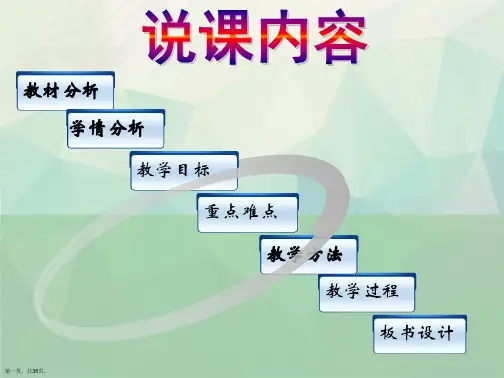
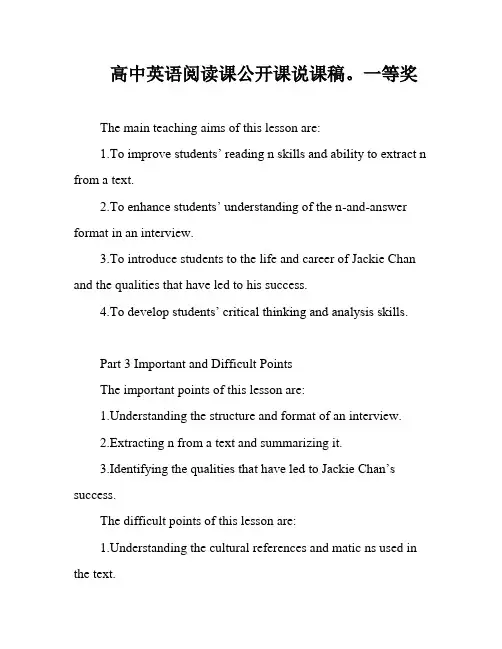
高中英语阅读课公开课说课稿。
一等奖The main teaching aims of this lesson are:1.To improve students’ reading n skills and ability to extract n from a text.2.To enhance students’ understanding of the n-and-answer format in an interview.3.To introduce students to the life and career of Jackie Chan and the qualities that have led to his success.4.To develop students’ critical thinking and analysis skills.Part 3 Important and Difficult PointsThe important points of this lesson are:1.Understanding the structure and format of an interview.2.Extracting n from a text and summarizing it.3.Identifying the qualities that have led to Jackie Chan’s success.The difficult points of this lesson are:1.Understanding the cultural references and matic ns used in the text.2.Anal yzing the author’s tone and purpose in the interview.Part 4 Studying MethodsTo achieve the teaching aims。

高中英语阅读课此说课稿独家特色简介:一,高中英语阅读课,该说课稿在赛课中获得了一等奖,同时该阅读课获得了一等奖,经过实战演练,课堂气氛非常活跃,阅读表格等教学方法得到评委一致称赞二,该说课稿内容超级翔实,脉络十分清晰,课程设计非常有趣有创意。
三,拥有配套的高质量的教案,课件,阅读原文,让你把优秀阅读课信手拈来!教案题目:高中英语阅读课公开课教案一等奖课件题目:高中英语阅读课公开课课件一等奖阅读原文题目:An interview with Jackie Chan 高中英语阅读课公开课原文InterpretationGood morning, ladies and gentlemen. It’s my great honor and pleasure to be here sharing my lesson with you.I have been ready to begin this representation with five parts. Analysis of the teaching material, the teaching aims, the important and difficult points, the studying methods, and the teaching procedure.Part 1 Teaching MaterialThe content of my lesson is a reading material, through the learning of which, I’ll enable students to know more about Jackie Chan, his life career and the qualities that lead to his success. At the same time, make Ss aware of the question-and-answer format in an interview and learn how to conclude a question from the answer.Part 2 Teaching AimsAccording to the new standard curriculum and the syllabus (新课程标准和教学大纲), and after studying the teaching material, the teaching aims are the followings:1.Knowledge objects (语言目标:语音,词汇,语法,功能,话题)(1)The Ss can learn question-and-answer format in an interview.(2) The Ss can understand the content of the lesson, talk about Jackie Chan’s life career andform their own opinion about success.2.Ability objects (技能目标:听,说,读,写)(1) To develop the Ss’ abilities of listening, speaking, reading and writing(2) To improve Ss' reading abilities, especially their skimming and scanning abilities.(3) To train the Ss’ abilit ies of studying by themselves and through cooperating.3.Emotion or moral objects (情感目标:兴趣,自信,合作,爱国,国际视野)Learn from Jackie Chan and understand the way to success is not smooth. Put the moral education in the process of study.Part 3 the Important and Difficult PointsThe important points are what qualities are required to be successful? Such as creativity, persistence and talent.The difficult points are Help students to conclude the questions of interviewers according to Jackie Chan’s answers.Part 4 Teaching MethodsAs is known to us all, a good teaching method requires that the teacher should help Ss develop good sense of the English language. For achieving these teaching aims,(after the analysis of the teaching material and teaching aims,) I will use the following methods according to the modern social communication teaching theories.municative Approach(交际教学法)2.Task-based Language Teaching (任务教学法)3.Total Situational Action (情景教学) a “scene —activity”teaching method , it establishes a real scene and the interaction between the teacher and the Ss. At the same time, CAI (电脑辅助教学) can provide a real situation with its sound and picture, it can develop the Ss creativity in learning English.Part 5 Teaching ProcedureStep 1. Lead-in. (3min)Greeting and play a related videoPurpose of my design:To arouse students' interest and lead in the topic for this lesson.Step 2. Pre-readingTask 1. (Individual work, pair work, group work, class work; 8min)Let Ss Get Ss to know something about Jackie Chan.Step 3. While-reading 22minTask 1.Skimming: Ss should read the material fast to conclude the possible questions Task 2.Scanning: Say what the comments tell you about Chan’s attitude to himself and his career. Step 4. Post-reading 12minTask 1Let Ss make further discussionTask 2. BrainstormDoes the interviewer tell you what you want to know about Jackie Chan? If Jackie Chan comes to our school and you will interview him on behalf of our school, what questions will you ask him?Step 5. HomeworkWhat do you think is the most important quality to be successful? Relate it to how to be successful in college entrance examination.Write down your opinion in the form of an essay. (120 words)。
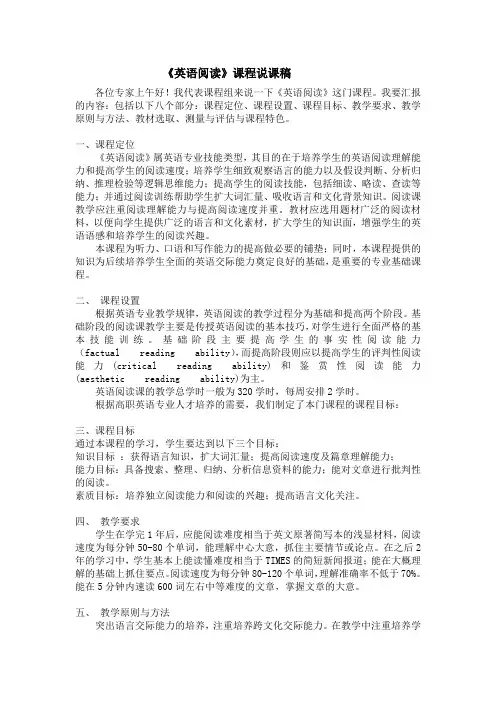
《英语阅读》课程说课稿各位专家上午好!我代表课程组来说一下《英语阅读》这门课程。
我要汇报的内容:包括以下八个部分:课程定位、课程设置、课程目标、教学要求、教学原则与方法、教材选取、测量与评估与课程特色。
一、课程定位《英语阅读》属英语专业技能类型,其目的在于培养学生的英语阅读理解能力和提高学生的阅读速度;培养学生细致观察语言的能力以及假设判断、分析归纳、推理检验等逻辑思维能力;提高学生的阅读技能,包括细读、略读、查读等能力;并通过阅读训练帮助学生扩大词汇量、吸收语言和文化背景知识。
阅读课教学应注重阅读理解能力与提高阅读速度并重。
教材应选用题材广泛的阅读材料,以便向学生提供广泛的语言和文化素材,扩大学生的知识面,增强学生的英语语感和培养学生的阅读兴趣。
本课程为听力、口语和写作能力的提高做必要的铺垫;同时,本课程提供的知识为后续培养学生全面的英语交际能力奠定良好的基础,是重要的专业基础课程。
二、课程设置根据英语专业教学规律,英语阅读的教学过程分为基础和提高两个阶段。
基础阶段的阅读课教学主要是传授英语阅读的基本技巧,对学生进行全面严格的基本技能训练。
基础阶段主要提高学生的事实性阅读能力(factual reading ability),而提高阶段则应以提高学生的评判性阅读能力(critical reading ability)和鉴赏性阅读能力(aesthetic reading ability)为主。
英语阅读课的教学总学时一般为320学时,每周安排2学时。
根据高职英语专业人才培养的需要,我们制定了本门课程的课程目标:三、课程目标通过本课程的学习,学生要达到以下三个目标:知识目标:获得语言知识,扩大词汇量;提高阅读速度及篇章理解能力;能力目标:具备搜索、整理、归纳、分析信息资料的能力;能对文章进行批判性的阅读。
素质目标:培养独立阅读能力和阅读的兴趣;提高语言文化关注。
四、教学要求学生在学完1年后,应能阅读难度相当于英文原著简写本的浅显材料,阅读速度为每分钟50-80个单词,能理解中心大意,抓住主要情节或论点。
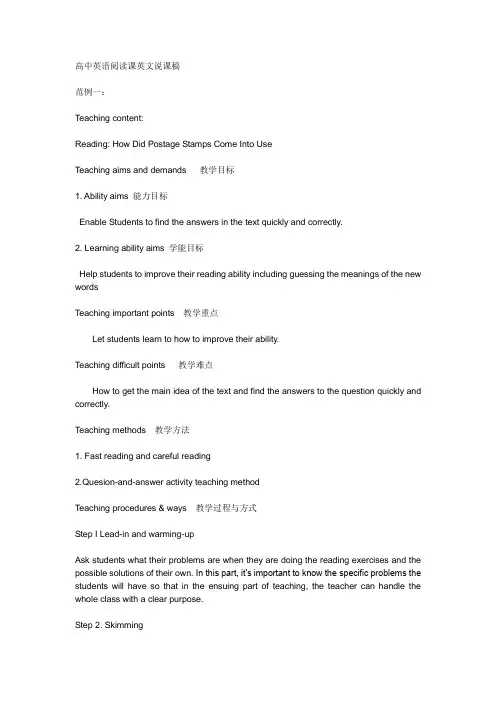
高中英语阅读课英文说课稿范例一:Teaching content:Reading: How Did Postage Stamps Come Into UseTeaching aims and demands 教学目标1. Ability aims 能力目标Enable Students to find the answers in the text quickly and correctly.2. Learning ability aims 学能目标Help students to improve their reading ability including guessing the meanings of the new wordsTeaching important points 教学重点Let students learn to how to improve their ability.Teaching difficult points 教学难点How to get the main idea of the text and find the answers to the question quickly and correctly.Teaching methods 教学方法1. Fast reading and careful reading2.Quesion-and-answer activity teaching methodTeaching procedures & ways 教学过程与方式Step I Lead-in and warming-upAsk students what their problems are when they are doing the reading exercises and the possible solutions of their own. In this part, it’s important to know the specific problems the students will have so that in the ensuing part of teaching, the teacher can handle the whole class with a clear purpose.Step 2. Skimming1. InstructionsGive students a passage to read and write a question “Who put forward the proposal to use stamps.” on the blackboard. Ask students read the passage quickly and find the answer. Limit the time to only two and a half minutes.(这一部分旨在教会学生略读方法,快速通篇阅读文章,抓住大意,纠正逐字阅读的错误方法,并找到问题的答案)2. Handing out the reading materialReading Material:How Did Postage Stamps Come Into UseWhen you send a letter or a postcard, you have to put stamps on the envelope or on the card. When did people first begin to use stamps? Who was the first to think of this idea? In the early nineteenth century, people did not use stamps. They had to pay postage when they received letters. They were unhappy about this, especially when they paid for a letter which they did not wish to receive at all. The postage was high at that time, because the post offices had to send many people to collect the postage.Rowland Hill, a schoolmaster in England, was the first to put forward a proposal to use stamps. He thought it would be much easier for people to use stamps to cover postage. They could go to the nearby post office to buy stamps and put them on envelopes before they sent the letters. The post office could simply put seals on the stamps so that people could not use the stamps again. In this way, the post office did not need to send postmen to collect postage. It only needed to send fewer postmen to deliver letters. That was a good idea and the government finally accepted it.On May 6, 1840, post offices throughout England began to sell stamps. Soon this new postal system was taken up by other countries. Now each country has its own stamps. And there are many people who collect stamps all over the world.3. CheckingQ: Who put forward the proposal to use stamps.A: Rowland Hill, a schoolmaster in England.4.Conclusion检查学生是否在限定的两分半的时间里是否通篇阅读完文章,并且找到了答案,摒弃逐字阅读方法,通过略读抓住文章大意Step 3. ScanningGive three minutes to read the passages again and find the answers to the two questions.1. Why was the postage high in the early nineteenth century when people did not use stamps?2. When was postage stamps first put to use?Ans. to Que.1. Because the post offices had to send many people to collect the postage. Ans. to Que.2. On May 6, 1840.Concusion在上一步骤的基础上,再次阅读文章,授于寻读方法,即寻找问题的语句在文章中出现的位置,根据原句回答所给的问题。

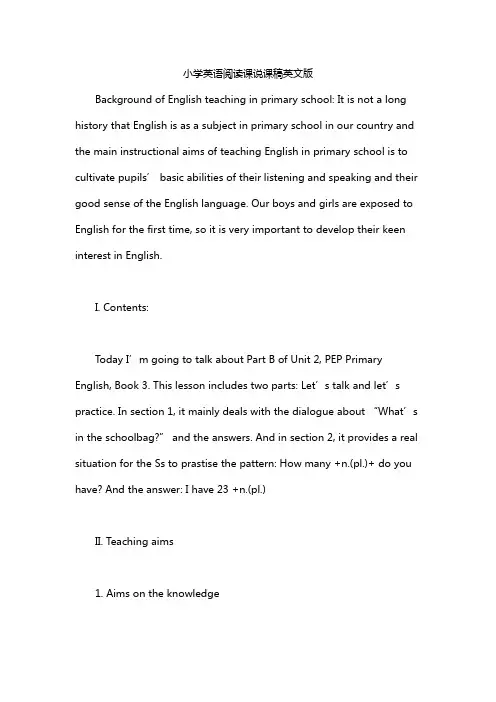
小学英语阅读课说课稿英文版Background of English teaching in primary school: It is not a long history that English is as a subject in primary school in our country and the main instructional aims of teaching English in primary school is to cultivate pupils’ basic abilities of their listening and speaking and their good sense of the English language. Our boys and girls are exposed to English for the first time, so it is very important to develop their keen interest in English.I. Contents:Today I’m going to talk about Part B of Unit 2, PEP Primary English, Book 3. This lesson includes two parts: Let’s talk and let’s practice. In section 1, it mainly deals with the dialogue about “What’s in the s choolbag?” and the answers. And in section 2, it provides a real situation for the Ss to prastise the pattern: How many +n.(pl.)+ do you have? And the answer: I have 23 +n.(pl.)II. Teaching aims1. Aims on the knowledge(1) To enable the Ss to un derstand and speak: “My schoolbag is heavy. What’s in it? Thank you sooooooo much.” Make sure that Ss can use these sentences in real situations.(2) To help Ss to finish the survey.(3) Let Ss finish the assessment of “Let’s check” in this unit.2. Aims on the abilities(1) To develop Ss’ abilities of listening and speaking.(2) To train the Ss’ ability of working in groups.(3) To foster Ss’ abilities of communication and their innovation.3. Aims on the emotion(1)To foster Ss’ consciousness of good co-operation and proper competition.(2) To lead Ss to show their loveliness to the poor.III. Key-points of this lesson(1) To help Ss ask and answer the question: What’s in it?(2) To enable Ss to study in groups and co-operate skillfully.(3) To develop Ss’ interest in English.IV. Difficult points(1) To help the Ss ask and answer the question “What’s in it?” and make sure they can use the plural nouns correctly.(2) To finish the survey by themselves.V. Teaching methodsAs we all know: the main instructional aims of learning English in primary school is to cultivate pupils’ basic abilities of listening and speaking and their good sense of the English language. So in this lesson I’ll mainly use “Task-based” teaching method. That is to say, I will letthe Ss learn in real situations, finish a task by making a survey to help the Ss to get a better understanding of the key structure of the dialogue. I will arrange four kinds of activities: singing, guessing game, finishing a survey and having a competition. And in this lesson a recorder, CAI, school things and a printed form will be needed. Students should prepare some school things.VI. Teaching procedures and purposes of my designing.I’ll finish this lesson in five steps.Step 1. Warm-up and preview1. Free talk between T and Ss about things in the classroom.2. Sing the song together: Books and pencils.3. Do some TPR, for example: Show me your English book. Show me your crayon.4. Review the numbers by asking: “How many crayons do you have?”Purpose: It is important to form a better English learning surrounding for the Ss by singing and doing some total physical response and at the same time it provides situations to review learned knowledge for the next step.Step 2. PresentationNow I’ll mainly talk about this step.1. Present the pattern: “My schoolbag is heavy.” “What’s in it?.”(1) Show a bag and say: “Look! I have a bag.” Carry it and say: “Oh, it is heavy. My schoolbag is heavy.” Help the Ss understand the meaning with the help of my body language. Then lead the Ss to read the sentence. Make sure they can say it correctly.(2) T: My schoolbag is heavy.Open the bag and say: “What’s in it? What’s in my schoolbag?”Take out a Chinese book. Then do the action again. Let the Ss read the sentence.2. Play a guessing game. Divide the whole class into four groups to have a competition.Let them guess: What’s in the bag? How many? Purpose: To present the key structures one by one is much easier for the Ss to learn and grasp the meanings. Proper competition can arouse the Ss’ interest in English learning.3. With the help of the CAI to present the dialogue. Set a situation to help Ss understand: Two Ss are coming. One girl is carrying a heavy bag on her back. They are talking.Girl: My schoolbag is heavy.Boy: What’s in it?Girl: 20 story-books, 32 pencil, 9 rulers, 12 crayons and 30 picture-books. Etc.Boy: What will you do?Girl: They are for the poor.Bo y: Great! I’ll bring some school things too.The boy comes back home and puts a lot of things into the bag. Then he goes to school again and gives them to a teacher. While he is taking them out, he is counting the numbers of all things. The teacher says: Thank you soooooooo much.4. Mention that we should take care of the poor.5. Play the cassette. Let the Ss listen and imitate the dialogue.Pay attention to their pronunciation and intonation. Purpose: CAI can provide a real situation for the Ss to understand the dialogue and the relationships between people better. Tell the Ss we should show our loveliness to the Ss.Step 3. PracticeDivide Ss into groups of six children. Each one would finish the printed form by asking and answering: How many storybooks do you have? Find out which group finishes faster. Story books picture-books sharpeners crayons pencils erasers pencil-cases rulers Chen Jie 8 24 3 32 26 4 1 3 Purpose: Task-based teaching method is used here to develop Ss’ ability of communication and also their ability of co-operation will be well trained.Step 4. AssessmentHelp Ss finish “Let’s check” of this unit and workbook.Purpose: To check the knowledge Ss have learned in this period.Step 5. Add-activity1. Let Ss tell each other how many school things they have after class. Tell their parents how many school things they have at home.2. Take care of everything they have.Purpose: Revision is so important that Ss should speak English as much as they as in class or after class. It is necessary for the Ss to do some extensive exercises after class to consolidate the knowledge they learned.。

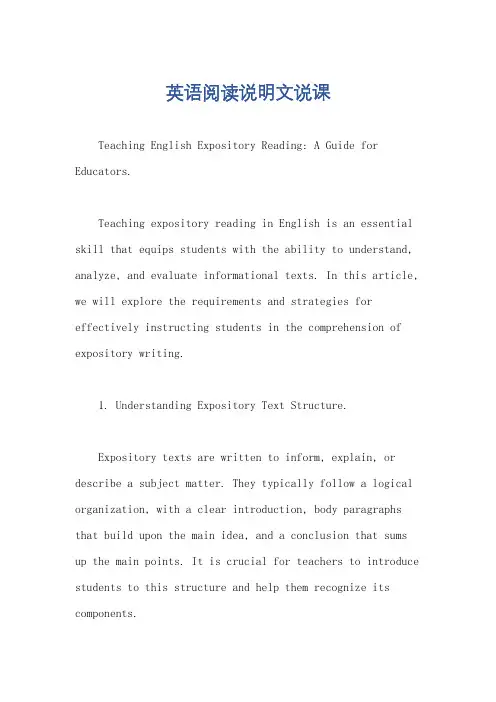
英语阅读说明文说课Teaching English Expository Reading: A Guide for Educators.Teaching expository reading in English is an essential skill that equips students with the ability to understand, analyze, and evaluate informational texts. In this article, we will explore the requirements and strategies for effectively instructing students in the comprehension of expository writing.1. Understanding Expository Text Structure.Expository texts are written to inform, explain, or describe a subject matter. They typically follow a logical organization, with a clear introduction, body paragraphs that build upon the main idea, and a conclusion that sums up the main points. It is crucial for teachers to introduce students to this structure and help them recognize its components.2. Focusing on Vocabulary and Syntax.Expository texts often contain complex vocabulary and sentence structures. Teachers should provide students with opportunities to practice these language elements through contextualized learning. This could include word lists, sentence analysis, and reading comprehension activitiesthat focus on vocabulary and syntax.3. Teaching Comprehension Strategies.To comprehend expository texts, students need to develop a set of strategies. Teachers can guide students in skimming and scanning techniques to quickly identify key information. They can also teach them to ask questions, predict outcomes, and make connections between ideas in the text.4. Encouraging Critical Thinking.Expository reading goes beyond mere comprehension; itinvolves evaluating the information presented. Teachers should foster a classroom environment that encouragescritical thinking. This can be achieved through discussions, debates, and writing assignments that require students to analyze and evaluate the content of expository texts.5. Incorporating Multimedia Resources.Incorporating multimedia resources such as videos, podcasts, and interactive websites can enhance students' understanding of expository texts. These resources provide visual and auditory aids that make complex concepts more accessible.6. Providing Regular Practice.Regular practice is essential for developingproficiency in expository reading. Teachers should assign regular reading assignments that expose students to avariety of expository texts. This will help them become more familiar with the language and structure of these texts, and improve their comprehension skills.7. Assessing Progress.Assessing students' progress is crucial for monitoring their understanding and identifying areas for improvement. Teachers can use a variety of assessment tools such as quizzes, tests, and rubrics to evaluate students' comprehension and critical thinking skills.8. Differentiating Instruction.Recognizing that students have different levels of reading proficiency, teachers should differentiate their instruction to cater to the needs of all learners. This could involve providing different reading materials, adjusting the complexity of assignments, or offering additional support to students who need it.In conclusion, teaching expository reading in English requires a structured approach that focuses on vocabulary, syntax, comprehension strategies, critical thinking, and regular practice. By providing students with a solidfoundation in these areas, teachers can help them develop into confident and proficient readers of expository texts.。

英语阅读课说课稿英文版Title: English Reading Course Tutorial Speech (English Version)Dear classmates,Today, I would like to share with you my perspective on the English reading course. As a language learner, I believe that reading is one of the most effective ways to improve our English skills. Not only can it help us expand our vocabulary and improve our grammar, but it can also enhance our listening and speaking abilities.In the English reading course, we should focus on selecting high-quality materials that are appropriate for our language level. It is important to choose materials that are challenging but not too difficult, so that we can still enjoy the reading process. Additionally, we should practice our reading comprehension skills by trying to understand the meaning of difficult words and phrases, as well as the overall context of the text.In addition to reading, we should also try to incorporate other language activities into our daily routine, such as listening, writing, and speaking. These activities can help us build our language skills in a more comprehensive and effectiveway.To sum up, I believe that the English reading course is an essential part of our language learning journey. By selecting the right materials and practicing our reading comprehension skills, we can effectively improve our English language abilities and achieve our language learning goals.Thank you.拓展:The English reading course is an essential part of any English language learning program. Reading is a crucial skill that needs to be developed in order to improve one"s English language proficiency. As language learners, we need to immerse ourselves in English language materials and try to understand their meaning and context.In addition to reading, it is also important to practice other language activities, such as listening, writing, and speaking. These activities can help us integrate our language skills and develop a more comprehensive understanding of the English language.When it comes to selecting reading materials, it is important to choose materials that are challenging but not too difficult. We should focus on selecting materials that areappropriate for our language level and interest level. Reading materials from different genres, such as fiction, non-fiction, and humor, can provide us with a diverse range of language and cultural experiences.In conclusion, the English reading course is an essential part of any English language learning program. By selecting the right materials and practicing our reading comprehension skills, we can effectively improve our English language abilities and achieve our language learning goals.。
高中英语阅读课英文说课稿1000字Good afternoon, everyone.Today, for our high school English reading class, we willbe discussing a short passage about the concept ofdiversity.The passage describes how diversity is no longer just about race and ethnicity, but includes a wide range of characteristics, such as gender, sexual orientation, and socio-economic status. The author argues that we must embrace and celebrate this diversity in order to promote equality and fairness in our society.Firstly, let’s take a look at the language and vocabulary used in this passage. The author uses straightforward and accessible language, with relatively simple sentence structures. However, the author also includes some more complex words and phrases, such as “socio-economic status”and “unwarranted assumptions”. This allows for a good mix of vocabulary for students to encounter and explore.Next, we should consider the cultural and social context of this passage. In today’s world, diversity has become an important topic of discussion, as we strive towards greater inclusivity and understanding of different perspectives. In this passage, the author argues that diversity is notsimply a matter of accepting differences, but actively celebrating them. This message is particularly relevant in our current society, where issues of discrimination and social inequality are still prevalent.Moving on to the reading skills that students can develop through this passage, there are a few key areas that we can focus on. Firstly, students can work on their comprehension skills by answering questions about the main idea and supporting details of the passage. They can also engagewith critical thinking by analyzing the author’s argumentand considering their own opinions on the topic of diversity. Additionally, this passage provides a useful opportunity to practice vocabulary acquisition and sentence structure through close reading and annotation.Finally, in terms of teaching strategies, I would suggest incorporating a mixture of individual and collaborative activities. Students could start by reading the passage independently and identifying the main ideas and supporting evidence, before discussing their findings in small groups or as a class. They could then engage with criticalthinking and opinion-sharing through a debate or class discussion. Vocabulary and language skills can be practiced through activities such as matching exercises and sentence completion tasks.In conclusion, this passage on diversity provides an engaging and thought-provoking topic for our high school English reading class. Not only does it expose students to a range of relevant vocabulary and ideas, but it also encourages them to develop their comprehension and analytic skills. Thank you for listening, and I hope you will find this lesson both informative and enjoyable.。
---一、课程背景与目标1. 课程背景随着全球化进程的加快,英语作为国际通用语言的重要性日益凸显。
阅读课作为英语教学的重要组成部分,旨在培养学生的阅读理解能力、语言运用能力和跨文化交际能力。
本节课以人教版高中英语教材为例,针对《Unit X》进行阅读教学。
2. 教学目标知识目标:掌握本单元的核心词汇和语法点。
理解文章的主旨大意和细节信息。
了解相关背景知识,拓展文化视野。
能力目标:提高阅读速度和理解能力。
培养批判性思维和问题解决能力。
增强语言运用和跨文化交际能力。
情感目标:激发学生对英语学习的兴趣。
培养学生的自信心和合作精神。
增强学生的国际视野和跨文化意识。
二、教学重难点1. 教学重点理解文章的主旨大意和细节信息。
掌握本单元的核心词汇和语法点。
培养学生的阅读策略和技巧。
2. 教学难点理解文章的深层含义和文化背景。
运用所学知识进行有效表达和交流。
培养学生的批判性思维和问题解决能力。
三、教学过程1. 导入利用图片、视频或音乐等导入,激发学生的兴趣。
通过提问或小组讨论,引导学生回顾旧知识,为新知识的学习做好铺垫。
2. 预读让学生快速浏览文章,了解文章的大致内容和结构。
引导学生预测文章的主题和可能出现的词汇。
3. 阅读理解细节理解:引导学生找出文章中的关键信息,如人物、事件、时间、地点等。
主旨大意:引导学生概括文章的主旨大意,理解作者的写作目的。
推理判断:引导学生根据文章内容进行推理和判断,培养逻辑思维能力。
词汇理解:引导学生理解文章中的生词和短语,掌握其用法。
4. 课堂活动小组讨论:将学生分成小组,围绕文章内容进行讨论,培养学生的合作精神和交流能力。
角色扮演:让学生扮演文章中的人物,进行角色扮演,提高学生的语言运用能力。
问题解答:解答学生在阅读过程中遇到的问题,帮助学生更好地理解文章。
5. 总结回顾本节课的学习内容,强调重点和难点。
引导学生总结阅读技巧和方法,提高阅读效率。
布置课后作业,巩固所学知识。
四、教学评价1. 形成性评价观察学生的课堂表现,如参与度、合作精神、表达能力等。